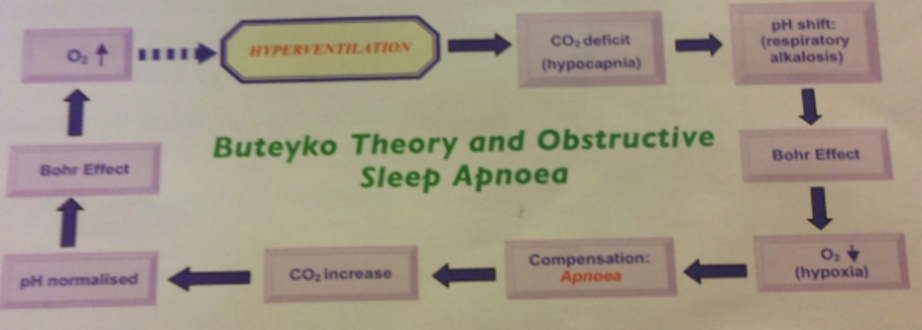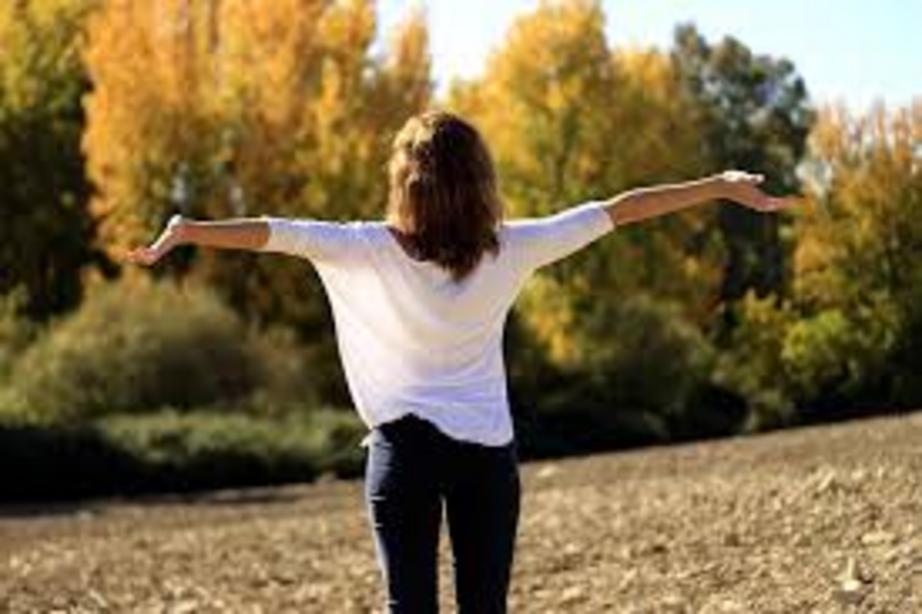Asthma, CO2 and over-breathing
It was encouraging to read Heart’s Gas Boost by Lucie van den Berg in the Herald Sun October 16, 2017. Survivors of cardiac arrest are to take part in a ‘world -first’ trial where they will have their blood levels of carbon dioxide increased in an attempt to lessen damage to the brain. The increased levels of the gas achieved by the use of a ventilator will result in greater perfusion of the brain minimising the risk of neurological damage after the cardiac event. This occurs because a higher level of CO2 contributes to a greater unloading of oxygen in the form of oxyhaemoglobin to the tissues. This mode of action is known as the Bohr effect referring to the observation that increases in the carbon dioxide partial pressure of blood or decreases in blood pH result in a lower affinity of hemoglobin for oxygen. Thus more oxygen is made available to body organs and tissues, in this instance, the brain.
An understanding of this process forms the very basis of the Buteyko Breathing Method developed by Professor Konstantin Buteyko in Russia back in 1952. In his chapter on Konstantin Pavlovich Buteyko, in everything you need to know to take control of your asthma: asthma-free naturally author Patrick McKeown describes the doctor as a ‘simple yet extraordinary man (who) devoted his life to studying the human organism and made one of the most profound discoveries in the history of medicine.’ Buteyko was suffering from hypertension and wondered if his habit of over breathing might be the cause of his intractable condition. He began experimenting on himself, reducing his inhalations and found that his headaches and the pain in his kidney ceased. A research of the available studies at the time confirmed his discovery that deep breathing and the exhalation of too much carbon dioxide decreased the amount of oxygen going to vital organs.
The Buteyko Institute Method is scientifically based on the standard medical principles of respiration, the normalisation of breathing, and the Bohr Effect. The Buteyko exercises train people to breathe through their noses, reduce their breathing to normal levels, keep their mouths closed and thus retain a higher proportion of the CO2 produced by the body. This results in immediate improvement in asthma, sleep apnoea, snoring, emphysema, COAD, COPD, sinusitis, hay fever, rhinitis, blocked nose, allergies, bronchitis, bronchiectasis, panic and anxiety conditions, and many other respiratory problems.
The news of this world-first trial to reduce brain damage after cardiac arrest is heartening. It can also be seen as an endorsement of the Buteyko method of breathing and its ability to improve the health of sufferers of many common conditions.
I have been learning the Buteyko method of breathing for the last three months and would attest to its value in increasing my quality of life. After five years of insomnia and plenty of money spent on the latest sleep cure including around $2000 for a mandibular splint I finally sleep through the night. A sleep study had revealed that I had sleep apnoea, only mild, but my lived experience was awful all the same. Each night as bedtime neared I would switch off the wi-fi, turn off the TV, read a book and later dim the lights hoping that such sleep hygiene measures would result in the release of melatonin and ensure a good night’s rest. To no avail, I could not stop the cycle of poor sleep accompanied by frequent, sudden snorting and the sleep anxiety and daily tiredness that followed.
Neither my GP nor my sleep physician suggested that I try a natural therapy called Buteyko. In my desperate research to help my condition I came across the Buteyko breathing method which claimed to be the answer to sleep apnoea, snoring, asthma, nasal problems and anxiety. After reading many articles and books on the method I tried to teach myself but had little success. That was until I enrolled in a course run by Paul O’Connell, Breathing Course Conductor & Practitioner Trainer. The Buteyko Institute Method is taught by practitioners registered with the Buteyko Institute of Breathing & Health (BIBH). The course consists of 5 sessions of 90 minutes duration run over consecutive days. The lectures are accompanied by breathing reconditioning where the emphasis to breathe only through the nose is stressed along with the importance of a reduction in the minute volume of air inhaled thus increasing the level of CO2 in the lungs thereby improving the oxygen uptake in the cells and tissues of the body.
Buteyko has been taught in Australia for over 20 years where it was first used successfully for asthma but is now also being taught for relief of sleep apnoea. Results of a 2012 survey of Buteyko Institute Practitioners suggests that this method of breathing retraining might prove to be an alternative method of treating sleep apnoea to the CPAP machine and that further studies are needed. The survey found that:

Over 95% of clients with sleep apnoea had improved sleep and approximately 8o% of clients had been able to cease use of their CPAP machine or oral appliances.
This in encouraging as is the use of this method for retraining the breathing of asthmatics. The results of the first clinical trial in Australia held in Brisbane into the effects of the Buteyko Method of Breathing for asthmatics showed that those taking part were able to reduce their bronchodilator medication by 96%, their steroid medication by 49%, and their asthma symptoms by 71%.
As with any new skill, breathing retraining requires practice and an overall vigilance of how you are breathing throughout the day. If done properly this reduced breathing will also be how you breathe when asleep. This was exciting news to me. How I longed for sleep as I remembered it before it was disturbed by who knows, but probably a very disturbing life event.
Paul O’Connell, Director of Buteyko Health & Breathing explained that the course involved learning to reduce our intake of air and that we only need about 4-5 litres of air a minute but a lot of us are inclined to be far more greedy and inhale a hearty 14 litres. Surprisingly snoring is thought to be the body’s mechanism to have us slow our breathing and retain some valuable carbon dioxide. The physiology is really interesting and if this fairly simple adjustment to one’s life can restore health, well that is fantastic news.
Our breathing practice consisted of inhaling through our nose and holding our breath until we felt the first signs of being uncomfortable – of air hunger. I remember my first attempt at this and my result was a very poor 23 seconds. This measurement is called the Control Pause and represents the level of CO2 in the lungs. Over the 5 day course this improved to where I could hold my breath reasonably comfortably for 46 seconds and am pleased to say that I have continued my practice and my controls have improved to over 100 seconds and up to 2 minutes along with improvements in my sleep and general feeling of wellbeing.
There are many benefits to our health from experiencing higher levels of CO2. As you learn to breathe smaller volumes of air that result in higher level of carbon dioxide there is an increase in body temperature and in saliva levels. Both are signs that the circulation is improving along with a boost to the parasympathetic nervous system resulting in a feeling of calmness and well being.
In his book Breathless Sleep…no more, former sleep apnoea sufferer Paul Rodriguez discusses the importance of awareness in our ability to breathe well:
Awareness, or mindfulness, of our breathing is essential. Recognising how every day emotional and stressful states affect the volume and rate of breathing is essential to achieving a state of relaxation.
Other important principles of the Buteyko Institute Method may involve changes to diet and being aware that eating too much causes us to deepen our breathing. The best way to encourage healing is to avoid processed foods and concentrate on fresh fruit, vegetables and nuts if possible. Other lifestyles changes include sleeping on your left side if you can and always with your mouth closed which can be facilitated by lightly taping your mouth. And of course the importance of exercise and how this helps build up our levels of carbon dioxide contributing to the feeling of contentment.
I look forward to going to bed now confident that my sleep will not be punctuated by frequents awakenings and adrenaline surges. Apart from wanting a good night’s sleep, sleep apnoea is associated with hypertension, vascular and cardiovascular disease so it is best to find a cure and a natural one at that.
It is such a simple way to treat sleep apnoea but one largely ignored by medical practitioners. This is despite some very positive media stories such as the 2005 A Current Affair which aired a story concerning the case studies of sleep apnoea sufferers being taught by Paul O’Connell in Melbourne who were successfully able to give up their CPAP machines after retraining their breathing using the Buteyko Method. But it is no surprise that medical research remains fixated on high-tech solutions – there is much money to be made by selling mandibular splints and CPAP machines. Maybe Buteyko owes its neglect to its simplicity for it is hard to believe at first that this method will work. We are so accustomed to the technological quick fixes.
No this is not a treatment your average general practitioner or sleep physician is likely to recommend and especially now that the Australian government is scrapping rebates for natural therapies. Therapies which include the Alexander technique, aromatherapy, Bowen therapy, Buteyko, Feldenkrais, herbalism, homoeopathy, iridology, kinesiology, naturopathy, pilates, reflexology, Rolfing, shiatsu, tai chi, and yoga will no longer attract a rebate which although small was a sign that the community was recognising the health benefits of alternative therapies.
On October 13 the Australian Government announced its reforms to the private health insurance system which included dropping the rebates for various natural modalities. These non medical treatments are popular with around 14 million Australians using complementary therapies with private health insurance covering an average rebate of $30 per session. The scrapping of the rebates followed the review of the Australian Government Rebate on Natural Therapies for Private Health Insurance. The purpose of the Review was to make sure that the therapies were ‘underpinned by a credible evidence base that demonstrates their clinical efficacy, cost-effectiveness and safety and quality.’
The 2015 review found that for Alexander technique, Buteyko, massage therapy, tai chi, and yoga there was evidence, which was graded as low to moderate quality, that these natural therapies may improve certain health outcomes for a limited number of clinical conditions. However, in most cases the quality of the overall body of evidence was not sufficient to enable definite conclusions to be drawn about the clinical effectiveness of the therapies.
But all is not lost. There are financial reasons for the Austin hospital trial into the effects of increasing the CO2 levels of cardiac arrest patients. It costs $120,000 to care for a patient who is admitted to intensive care post cardiac arrest. So the hope is that the trial will result in a better outcome for the patient and the health budget. Would it be too much to ask that similar sensible rearrangements might be made to other conditions that cost the public purse far too much, such as subsidised medications for asthma?
But I live in a dream world. It must be the effects of higher levels of CO2.

